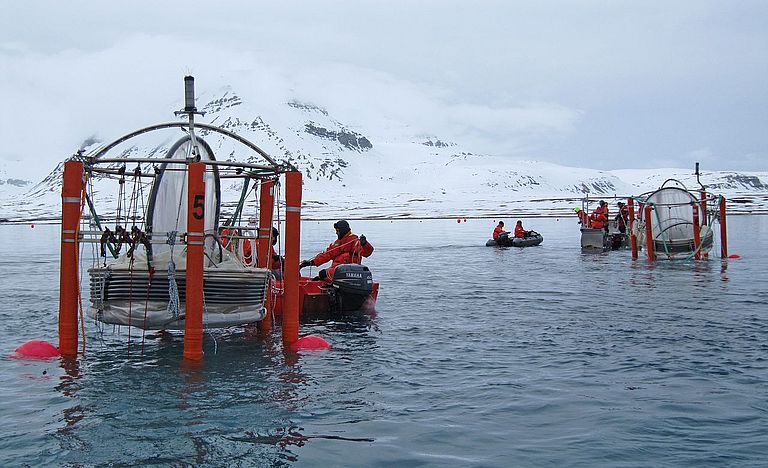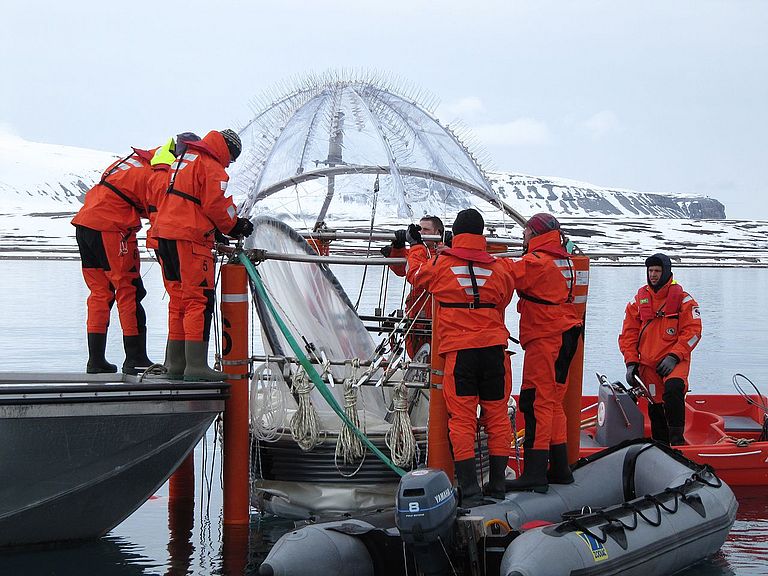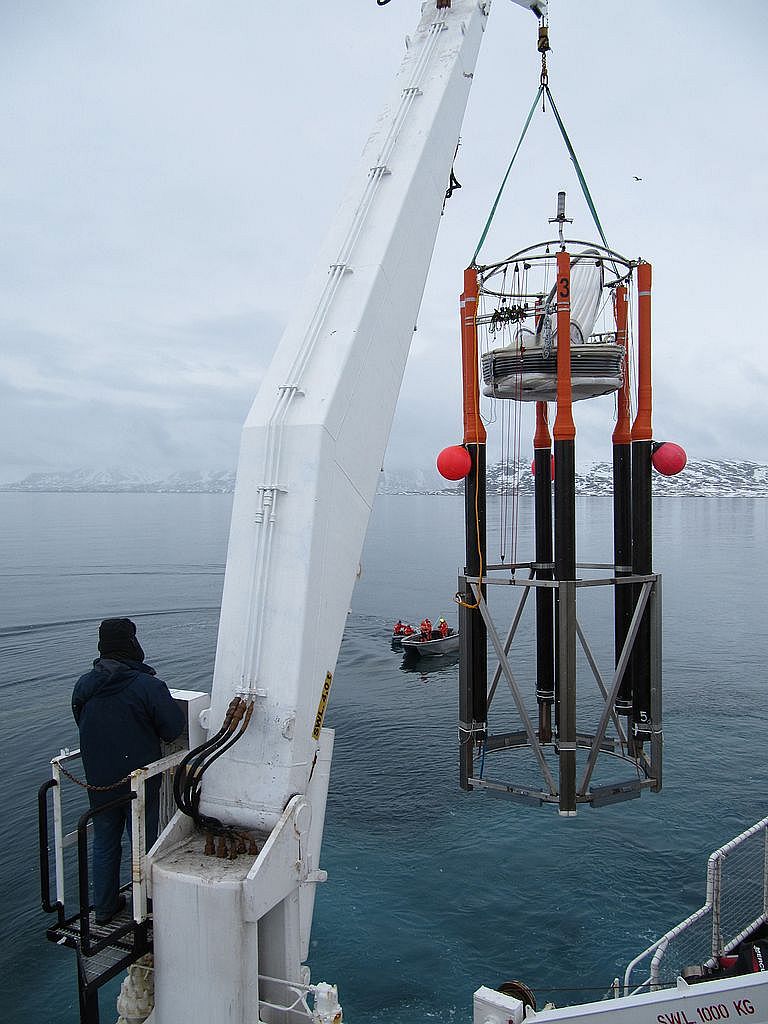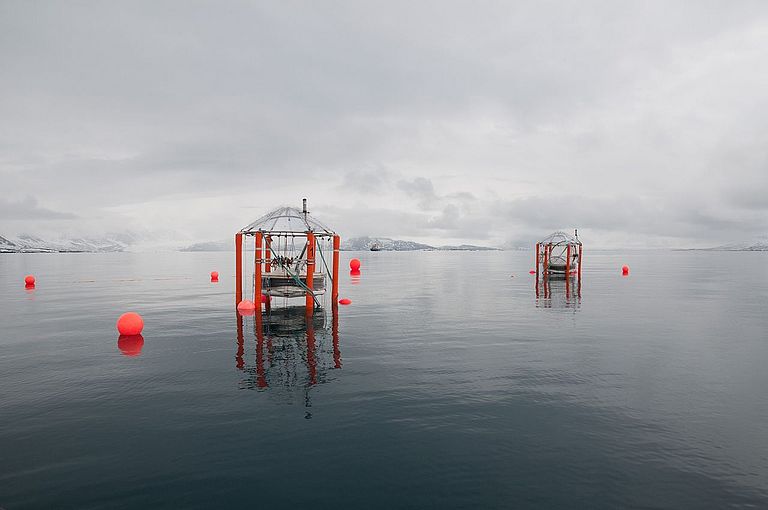Ocean Acidification in the Arctic
June, 3, 2010. Ny Ålesund, Spitsbergen. Carbon dioxide (CO2) emissions not only lead to global warming, but also cause another, less well-known but equally disconcerting environmental change: ocean acidification. A group of 35 researchers of the EU-funded EPOCA project have just started the first major CO2 perturbation experiment in the Arctic Ocean. Their goal is to determine the response of Arctic marine life to the rapid change in ocean chemistry.
Ocean acidity has increased by 30% since preindustrial times due to the uptake of anthropogenic CO2. It is projected to rise by another 100% before 2100 if CO2 emissions continue at current rates. Polar seas are considered particularly vulnerable to ocean acidification because the high solubility of CO2 in cold waters results in naturally low carbonate saturation states. CO2 induced acidification will easily render these waters sub-saturated, where seawater becomes corrosive for calcareous organisms. By the time atmospheric CO2 exceeds 490 parts per million (2040 to 2050, depending on the scenario considered), more than half of the Arctic Ocean is projected to be corrosive to aragonite. Arctic waters are home to a wide range of calcifying organisms, both in benthic and pelagic habitats, including shell fish, seas urchins, coralline algae, and calcareous plankton. Many of these are key species providing crucial links in the Arctic food web, such as the planktonic pteropods, which serve as food for fishes, seabirds and whales.
To study the impacts of ocean acidification on plankton communities, the Leibniz Institute of Marine Sciences (IFM-GEOMAR) has deployed nine mesocosms in the Kongsfjord off the north-western coast of Spitsbergen (Svalbard) supported by the Greenpeace vessel Esperanza. Each of the giant, 17 m long ‘test tubes’ holds about 50 cubic metres of seawater. The enclosed plankton community is exposed to a range of different CO2 levels as expected to develop between now and the middle of the next century and is closely monitored over a 6-week period. The EPOCA scientists, who are stationed at the Ny Ålesund research station, are sampling the mesocosms daily from zodiacs with plankton nets, water samplers and pumps, and conduct measurements with profiling sensors and in situ probes. The multidisciplinary experiment, which will last until mid July, involves molecular and cell biologists, marine ecologists and biogeochemists, ocean and atmospheric chemists. The scientists expect new results about the sensitivities of Arctic plankton communities to ocean acidification and their impacts on the Arctic food web and biodiversity, the cycling of carbon, nutrients and other elements, the production of climate relevant gases and their exchange with the atmosphere.
Background information
(1) The EU FP7 large-scale integrating project EPOCA (European Project on OCean Acidification) was launched in May 2008 with the overall goal to fill the numerous gaps in our understanding of ocean acidification and its consequences. The EPOCA consortium brings together more than 100 researchers from 27 institutes and 9 European countries. The research of this four-year long project is partly funded by the European Commission.
Project web site: http://epoca-project.eu.
(2) The following EPOCA partner institutions participate in the experiment: Alfred Wegener Institute for Polar and Marine Research (AWI, Germany), Centre National de la Recherche Scientifique (CNRS, France), Leibniz Institute of Marine Sciences (IFM-GEOMAR, Germany), Natural Environment Research Council (NERC, UK), Netherlands Institute of Ecology (NIOO, The Netherlands), Plymouth Marine Laboratory (PML, UK), Royal Netherlands Institute for Sea Research (NIOZ, The Netherlands), Station Biologique de Roscoff (France), University of Bergen (UiB, Norway). Participating on-EPOCA institutions: Norsk Polarinstitutt (Norway), University of Aarhus (Denmark), University of Oslo (Norway)
(3) The French participants of this experiment are supported in part by Institut Polaire Français – Paul Emile Victor (IPEV).
(4) This experiment is carried out with the on site logistical support of Greenpeace (vessel Esperenza), the French German research base AWIPEV and the Kings Bay research facility and with financial support of the EU project MESOAQUA (Network of European marine mesocosm facilities; http://www.mesoaqua.eu/).
Contact information
Andreas Villwock (Communication & Media), Phone: +49-431 600-2802,
avillwock@geomar.de






